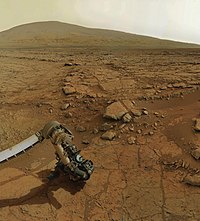
Photo from wikipedia
Perchlorate of natural origin is a persistent pollutant that affects thyroid function by inhibiting iodine uptake, and this pollutant is frequently detected in different ecosystems at concentrations that can harm… Click to show full abstract
Perchlorate of natural origin is a persistent pollutant that affects thyroid function by inhibiting iodine uptake, and this pollutant is frequently detected in different ecosystems at concentrations that can harm human health. In this study, we measured the perchlorate concentrations in 3,000 marine sediment samples from January to March in 2017, 2018, 2019, and 2020 during the 3 rd , 4 th , 5 th , and 6 th Colombian Scientific Expeditions to Antarctica. The sampling zones were located at 15 different points on the South Shetland Islands and Antarctic Peninsula, and they were measured using a selective perchlorate electrode. The concentration data indicate that perchlorate reached a minimum concentration of 90 ppm on Horseshoe Island and a maximum concentration of 465 ppm on Deception Island, suggesting a spatial variation in perchlorate concentrations that can be attributed to the natural formation of this pollutant due to volcanic eruptions. Additionally, homogeneous distribution of perchlorate was not observed in Antarctica.
Journal Title: Environmental Monitoring and Assessment
Year Published: 2022
Link to full text (if available)
Share on Social Media: Sign Up to like & get
recommendations!